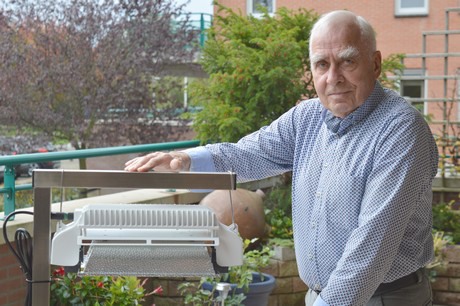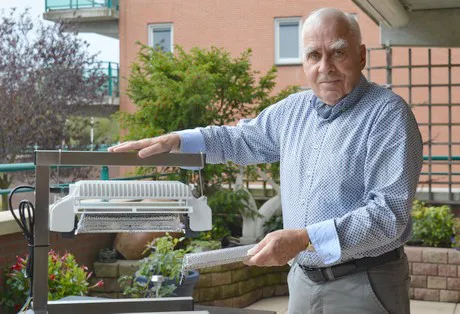He doesn’t speak Chinees and his English is shaky at best, but Harry Dullemans, the founder of Agrolux, is still a successful fixture developer. The fact that he is 77 years old doesn’t keep him from his work. In his workshop, he tinkers on new fixtures and the requests for his work keep coming in. “You should never say you’re not there because then they will pass you by.”
A phone call from China
Harry started his career constructing greenhouses at Voskamp and Vrijland, where he was involved in projects in France, England and Macedonia, to name a few. In the late 80s’, Harry stopped building. The horticultural industry seemed to be in the past for Harry until he received a phone call from China in 1990. “A University asked me to come to China to share my horticultural knowledge.”
Harry packed his bags and left for his 14 day trip to Ningbo. “We had a meeting from morning till night. The universities focused mainly on agriculture and saw there was a lot of potential for horticulture as well. To this day, I don’t know who told the Chinese professor about me, but its thanks to him, I was able to make my trip.”

Developing fixtures
After that first trip, many others soon followed, sometimes as much as six a year. As thanks for sharing his knowledge, the Chinese professors, in turn, asked if they could do something for Harry. Harry, who was already working on lights in the Dutch town of Hoek van Holland, asked if they could help him develop new, lighter and more energy efficient light fixtures. “The professors gathered a group of students and this is how, often till late into the night, the new fixtures were developed. The Chinese may not be known for making the best machines, but you shouldn’t underestimate their innovativeness.”
It’s all about the relationship
When the design was ready for production and the contracts were signed, an entire ceremony was organized. “Chinese state television was present to record the fact that work from abroad was brought into the country. It wasn’t the director of the factory that stood next to me on the podium, although he should have been given the honors, but the mayor of the city. He was, after all, the most important, which just shows how different things were back then.”
Harry often went to take a look inside the factory. “It is crucial to keep in contact with the people over there because if you don’t, it will go quiet. It’s all about the relationship. When you often sit down with the director and his family for dinner, things will run smoothly. That’s how things work in China.”
From Agrolux to Inluxit
All of this led to the founding of Agrolux back in 2002. Agrolux first hit the global market with an electronic fixture, and soon after, Harry was accompanied by his son Denis. Now, Agrolux produces assimilation lighting and provides these to the horticultural industry worldwide. Business was booming. “With a relatively small occupation, we had a great sales revenue”, Harry reminisces.
In 2010, Harry left Agrolux to focus all of his time on developing new innovations. His designs are thought up in his workshop, produced in China and tested in the Netherlands. In collaboration with a renowned innovative greenhouse construction company, they intend to bring the fixtures, under the name Inluxit, to market within the foreseeable future. “Our latest fixture has an intelligent starter and easily removable shades, so you can clean it without having to take apart the entire fixture.”

The development never stops
Throughout the years, the quality of lamps and fixtures has improved a lot. The electronic fixture ensured the equal distribution of light and the lamps now have a much longer lifespan. Harry, however, thinks that the development is still nowhere near done. “In terms of LED lighting, we have only just begun. The costs to make the product are still too high, even though much more will have to be made in the future. We also know relatively little bout the light patrons that each individual crop needs. I think that, when lighting is concerned, we are never done experimenting. It’s a shame I am growing older. I would have loved to witness it all.”
For more information:
Harry Dullemans
[email protected]
